ASUS P8Z68-V PRO Review: Our First Z68 Motherboard
by Ian Cutress on May 11, 2011 3:13 AM EST- Posted in
- Motherboards
- Asus
- Z68
LAN Speed Test
LAN Speed Test is a freeware program designed for testing the network connection between two PCs on a home network. The speed of the transfer is limited by the lowest common denominator on the network, so if you have gigabit Ethernet capable computers but a 100 Mbit capable router, you are limited to 100 Mbit transfer. Note that this is really a formality – if a network port is rated at 1 Gbps, then chances are that it will hit at least 90+% of this value. The main test here is CPU usage, and how much is offloaded by the controller. For this test, we use LAN Speed Test to transfer a 1000 MB file across a home network with a 100 Mbps lowest common speed to the same machine each time, in a read/write scenario. CPU usage is taken as a visual max/average from task manager.
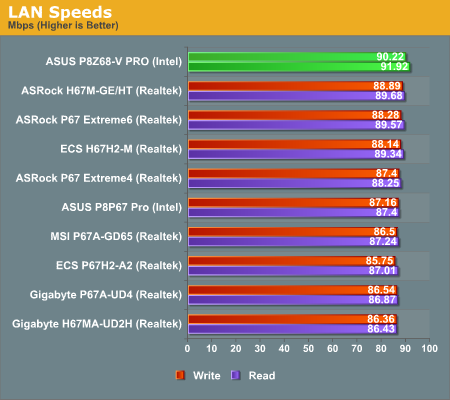
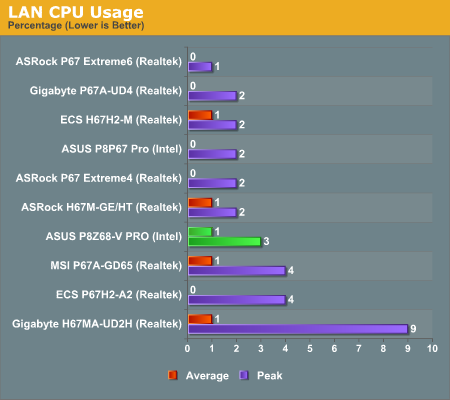
The board comes top in our read/write speed test by a decent margin, considering the 100 Mbps limit imposed by our router.
USB Speed
For this benchmark, we run CrystalDiskMark to determine the ideal sequential read and write speeds for the USB port using our 64GB Patriot SuperSpeed USB 3.0 drive. Then we transfer a set size of files from the SSD to the USB drive, and monitor the time taken to transfer. The files transferred are a 1.52 GB set of 2867 files across 320 folders – 95% of these files are small typical website files, and the rest (90% of the size) are the videos used in the Sorenson Squeeze test.

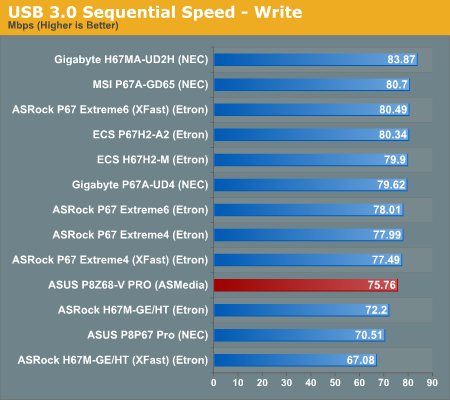
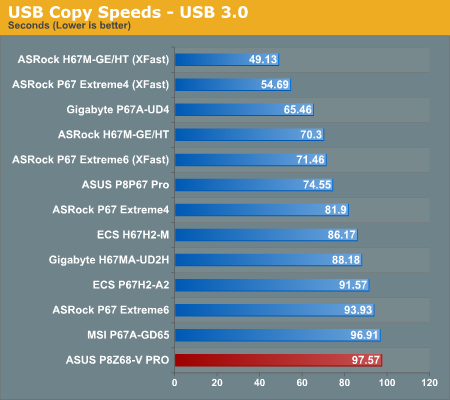
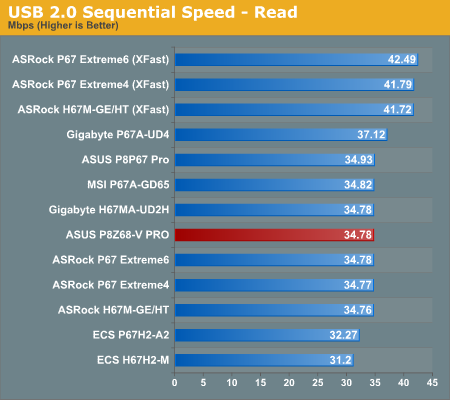


The board isn't setting any USB records, being near the bottom compared to other boards we've tested.
SATA Testing
We also use CrystalDiskMark for SATA port testing. The operating system is installed on the Micron RealSSD C300, which is rated at 355 MB/s read and 215 MB/s write, and the sequential test is run at the 5 x 1000 MB level. This test probes the efficiency of the data delivery system between the chipset and the drive, or in the case of additional SATA ports provided by a third party controller, the efficiency between the controller, the chipset and the drive.
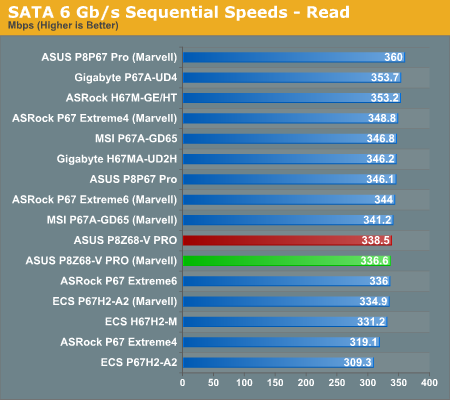
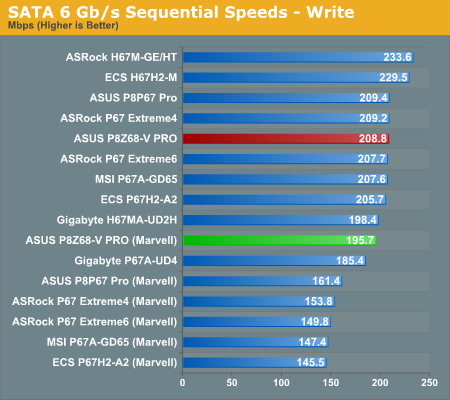

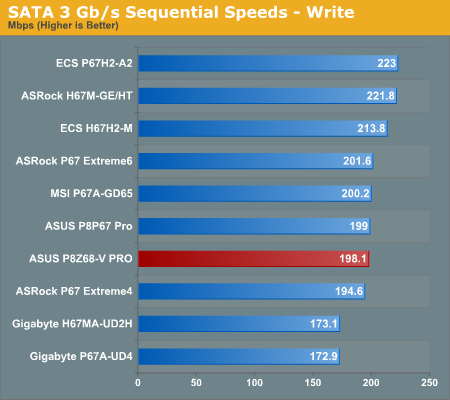
The ASUS board is near the middle of the pack when it comes to SATA speeds.
DPC Latency
Deferred Procedure Call latency is a way in which Windows handles interrupt servicing. In order to wait for a processor to acknowledge the request, the system will queue all interrupt requests by priority. Critical interrupts will be handled as soon as possible, whereas lesser priority requests, such as audio, will be further down the line. So if the audio device requires data, it will have to wait until the request is processed before the buffer is filled. If the device drivers of higher priority components in a system are poorly implemented, this can cause delays in request scheduling and process time, resulting in an empty audio buffer – this leads to characteristic audible pauses, pops and clicks. Having a bigger buffer and correctly implemented system drivers obviously helps in this regard. The DPC latency checker measures how much time is processing DPCs from driver invocation – the lower the value will result in better audio transfer at smaller buffer sizes. Results are measured in microseconds and taken as the peak latency while cycling through a series of short HD videos—under 500 microseconds usually gets the green light, but the lower the better.
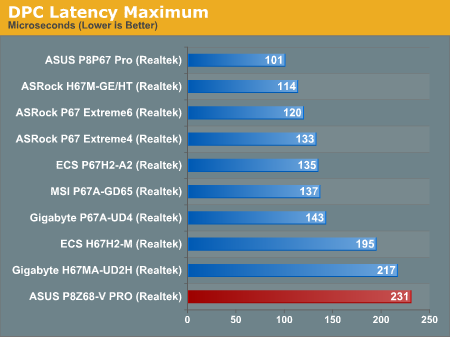
The ASUS board may have come bottom in the DPC test, but the result is stil under 500 microseconds, and for the most part it was under 120.










95 Comments
View All Comments
BernardP - Wednesday, May 11, 2011 - link
A practical question: If one wants to use i-mode or d-mode, is it necessary to install both the Intel video driver and the AMD or Nvidia video driver?Could this be a source of conflicts or other problems?
AnnihilatorX - Thursday, May 12, 2011 - link
Yes you need to install both. Not really on Vista and Windows 7, new driver models mean you can install multiple GPU drivers. I don't think Virtu supports older OS.BernardP - Thursday, May 12, 2011 - link
Thanks for the reply. Noted for future. After taking everything into consideration, including my usage pattern, I would simply deactivate intel IGP, not install Virtu and add an entry-level Nvidia videocard, such as the fanless Asus GT 520.The noteworthy other Z68 feature is SSD cache, but after reading the detailed article about this, I would prefer to go with a 120 GB SDD plus mirroring HDDs.
For me the single plus of the Z68 platform is that I would have Intel IGP as a temporary backup in case of failure of the discrete GPU. This is only worth a very small premium over P67.
vol7ron - Wednesday, May 11, 2011 - link
When you refer to BIOS, do you mean the UEFI BIOS Utility, or is there a dual BIOS/UEFI boot option?risa2000 - Wednesday, May 11, 2011 - link
I noticed in test setup description three different memory modules. Did you do some tests on memory throughput? Was there any difference?I wonder if it makes sense to go for faster memory beyond DDR3-1600.
AnnihilatorX - Thursday, May 12, 2011 - link
You are looking at about 2-5% performance increase from going DDR 1600 to DDR 2133No point buying expensive RAM unless you spot a bargain
L. - Thursday, May 12, 2011 - link
"expensive RAM" -- on the other hand there's quite a lot of relatively cheap around 2k mhz -- sticking to 1600 isn't that great nowadays.cyklonman - Wednesday, May 11, 2011 - link
P67 Asus looks much better, why did I wait for this one?fr500 - Wednesday, May 11, 2011 - link
Will this work?Hook up a monitor with two inputs and connecting a spare input to the motherboard's connector? As far as I know all you need is a display hooked up to one of the motherboard connectors, so if you have a display with 2+ inputs you could get one to your IGP, one to your GPU and switch to the IGP input when you want to do transcoding.
Best of both worlds, intact GPU performance and Quicksync.
Even if Virtu works 100% it still won't let you use your GPU control panel and any crashes might be harder to diagnose (ie: who should I blame, Lucid or NVidia/AMD)
Ryan Smith - Thursday, May 12, 2011 - link
Sure, that should work. Windows may or may not have quirks though, based on past experience.As for the control panel thing, I have not used Virtu in dGPU mode, but based on how Hydra works I'm sure the AMD/NV control panels work in dGPU mode. I wouldn't expect any crashes in that mode either since Virtu isn't intercepting the dGPU, but again I classify that with the fact that I haven't used dGPU mode yet.